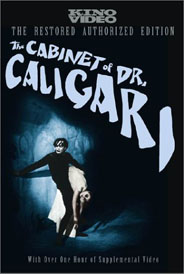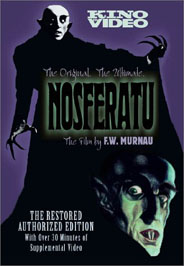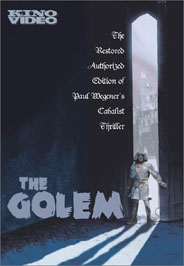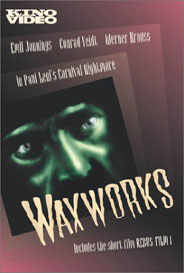| Release List | Reviews | Price Search | Shop | Newsletter | Forum | DVD Giveaways | Blu-Ray/ HD DVD | Advertise |
| Reviews & Columns |
|
Reviews DVD TV on DVD Blu-ray International DVDs Theatrical Reviews by Studio Video Games Features Collector Series DVDs Easter Egg Database Interviews DVD Talk TV DVD Talk Radio Feature Articles Columns Anime Talk DVD Savant HD Talk Horror DVDs Silent DVD
|
DVD Talk Forum |
|
|
| Resources |
|
DVD Price Search Customer Service #'s RCE Info Links |
|
Columns
|
 |
KINO |

|
Cabinet of Dr. Caligari Kino 1920 / b&w / 1:37 flat / 67 75 min. / Das Kabinett des Doktor Caligari / Street Date September 24, 2002 / $24.95 (or The German Horror Classics Box, $89.95) Starring Werner Krauss, Conrad Veidt, Friedrich Feher, Lil Dagover, Hans Heinrich v. Twardowski Cinematography Willy Hameister Production Designer Walter Reimann, Walter Röhrig, Hermann Warm Original Music (separate scores:) Donald Sosin, Rainer Viertblöck Restored by Transi Films GMBH Written by Hans Janowitz and Carl Mayer Produced by Rudolf Meinert, Erich Pommer Directed by Robert Wiene |
Supplements: Condensation of Wiene's Genuine: the Tale of a Vampire, Behind the Scenes promo footage of Wiene directing I.N.R.I., two musical scores, gallery of photos and artwork, samples of original German intertitles.
Caligari is probably the most famous silent horror film. It's been lauded for its sophisticated and complex view of mental illness, as much as its use of stylized theatrical settings to create an alternate psychological universe.
Viewers have always loved the way this film looks. At first Caligari's painted-backdrop sets seem foolish, but we slowly accept them as an alternate reality, seen through a distorting prism. Eventually we're given some rooftop sets, and a stylized bridge setting, that look flat but aren't, and lead to even further disorientation.
The actors, especially the two carnival villains, are also nicely stylized, with Cesare's diamond-shaped eye makeup and Caligari's smudgy face. The overall feeling is of a nightmare, a rather enclosed, Kafka-esque world. And Caligari has perhaps the screen's first fully developed movie monster, a loathesome but pitiful automaton submerged in some private hypnotic hell that we cannot even imagine.
Caligari makes very clever use of a flashback structure to play with reality on a psychological plane, which often prompts critics of German Expressionist film to make political hay out of the resemblance of the evil Caligari to the later Hitler. As if the makers could have had any such political intention, the reasoning debates whether the film is subversive or reactionary. The order established in the main flashback is eventually revealed to be a hoax, with a warped madman in control of the asylum, and only pretending to be a benevolent doctor ... until another twist comes along, and then another.
Savant has not seen the Image version of The Cabinet of Dr. Caligari on DVD, just their very good laserdisc effort from 1990. Overall, Kino's DVD is very impressive. The intertitles duplicate the style of the German originals, which helps a lot, as the sometimes long titles drag the pace down somewhat. For quality, the show is also good, with the expected variation from scene to scene - the picture is of course rather contrasty, showing its eighty years of age as much as any film of this era. There's one exception to this - the opening scene in the garden was either from a far worse original, or the telecine colorist goofed - the blue tinting blooms all over the images, posterizing the scene very distractingly. Thankfully, it's very brief. The framing also looks tight in some shots, particularly the bridge scene, that loses much of its extreme top.
The transfer speed is slower than the later sound standard 24fps., which allows the motions of the characters to always look appropriate. 1

|
Nosferatu, A Symphony of Horror Kino 1922 / b&w / 1:37 / 93 min. / Nosferatu, eine Symphonie des GrauensStreet Date September 24, 2002 / $24.95 (or The German Horror Classics Box, $89.95) Starring Max Schreck, Gustav von Wangenheim, Alexander Granach, Greta Schroeder Cinematography Fritz Arno Wagner, Gunther Krampf Art Direction Albin Grau Original Music (separate scores:) Gérard Hourbette, Thierry Zaboitzeff Restored by Cineteca del Comune di Bologna Written by Henrik Galeen from Dracula by Bram Stoker Produced by Enrico Dieckmann, Albin Grau Directed by F.W. Murnau |
Supplements: Excerpts from F.W. Murnau's Journey into the Night, The Haunted Castle, Phantom, The Last Laugh, and Tabu. Two Musical Scores, Photo Gallery, comparison of 'meeting Dracula' scenes in the novel, the screenplay and the film
Nosferatu, the first screen version of Dracula has had several DVD releases, and is discussed at in the Savant review of the Image Nosferatu disc.
I spot-compared this Kino copy with the earlier disc, and found that Kino's had some definite advantages. The tinting is more pronounced (as with all these Kino transfers) but the image looks a little sharper than Image's. Both have the same xerox-copy quality, but Kino's has the edge. The framing may be the most important improvement. In a key shot on board the death ship Demeter, the first mate watches as Nosferatu levitates to a standing position from his rat-infested coffin. Both versions have the same subtle jump cuts within the shot (frame damage?) but on the Image disc, when Schreck is full upright, on my monitor most of his head goes out of frame. On this Kino transfer, he stays in-frame, with a tiny margin to spare. I didn't take the time to do a more thorough comparison, but it's possible that these German source elements are a generation back, before this overcropping took place.
The Kino disc also claims to be 93 minutes, 12 longer than the length claimed on the Image box. I thought I saw more incidental scenes with Hutter's wife back in Wisborg, and there seemed to be more and longer intertitles, but even with a radical speed discrepancy between the two discs, this Kino release may be significantly longer.

|
The Golem Kino 1920 / b&w / 1:37 flat / 86 min. / Der Golem, wie er in die Welt kam / Street Date September 24, 2002 / $24.95 (or The German Horror Classics Box, $89.95) Starring Paul Wegener, Albert Steinrück, Lyda Salmonova, Ernst Deutsch, Hans Stürm Cinematography Karl Freund Production Designer Art Direction Hans Poelzig, Kurt Richter Set designer Edgar G. Ulmer Original Music Aljoscha Zimmerman Restored by Cineteca del Comune di Bologna Written by Henrik Galeen, Paul Wegener from the novel by Gustav Meyrink Produced by Paul Davidson Directed by Carl Boese & Paul Wegener |
Supplements: Excerpts from the 1936 Duvivier's 1936 Le Golem and F.W. Murnau's Faust; photo and artwork gallery
The Golem is particularly welcome on DVD, as Savant's best VHS tape was a cut-down and re-edited pastiche cobbled together for cable television. It's a classic monster story from Yiddish folklore. With the critical politicization of 1920's German Expressionist films, one might fear some kind of anti-semitic handling of the scenes of ghetto life and Jewish 'magic'. Savant could be way off base, but nothing of this sort stood out in the movie.
A fascinating story, this most famous version of The Golem has the remarkable performance of actor-director Wegener, who does indeed look like a clay statue, even in closeups. The production is the most lavish of the four films in this collection, with the expresionist art direction integrated more naturally (is this a contradiction?) and the Prague Ghetto sets constructed on a giant scale.
The Ghetto is overseen by a benevolent group of wise rabbis. Rabbi Lowe might as well be the sorcerer from 'The Sorcerer's Apprentice', with all of his magic encantations and secret knowledge of demonology - he can summon evil ancient gods and exploit their secret powers. This, coupled with the less-than-flattering characterizations of Miriam (innocent lover or sluttish wanton?) and Famulus (sneaky, jealous, ambitious), might lead one to think the film anti-semitic.
But the Ghetto is seen as a normally happy community where the Jews like living their separate cultural lives, and the Emperor's court is a definitely un-superior place of decadent dandies and elitists. Apart from Lowe's black magic, the rest of the Ghetto seems very devout and positive spiritual (especially in this longer version). As for the negative aspects of Miriam and Famulus, the point of the folk story in its original and later versions always centered on the human weaknesses of the mortals who misused the Golem.
The Golem is a parable with a wide application to the world we know, from Atomic Power to Frosty the Snowman; with the basic concept that Mankind is emotionally unqualified to wield dangerous power. "Built to serve" might be the Golem's motto, and The Rabbi wisely considers activating him only when the survival of his community is threatened. Everyone thinks the monster is an inert automaton, but it seems to absorb the 'vibes' of the people it encounters. When used for immoral ends, the Golem becomes emotionally outraged, and just plain goes nuts. James Whale's Frankenstein owes a lot to this show, and the resemblance is especially striking in the scenes where both monsters are confronted by innocent little children. The contrast shown when the unstoppable, indestructable Golem is felled by a tiny tot, gives the story a very satisfying ending.
Except for a tendency of its images to lack detail, The Golem is in pretty good shape. It plays a lot more smoothly with the extended footage of the Ghetto religious ceremonies. The long running time can be accounted for with the slower projection speed and added intertitles, but there must be considerable new material as well. Earlier 'versions' were disjointed cutdowns, but on this disc, the show finally plays like a full-length feature.

|
Waxworks Kino 1923 / b&w / 1:37 / 83 min. / Das Wachsfigurenkabinett / Strreet Date September 24, 2002 / $24.95 (or The German Horror Classics Box, $89.95) Starring Emil Jannings, Conrad Veidt, Werner Krauss, William Dieterle, Olga Belajeff, John Gottowt Cinematography Helmar Lerski Art Direction Paul Leni Costume Design Ernst Stern Original Music Jon C. Mirsalis Restored by Cineteca del Comune di Bologna Written by Henrik Galeen Directed by Leo Birinsky, Paul Leni |
Supplements: Paul Leni short film Rebus Film 1, excerpt from the silent The Thief of Bagdad.
Nice art direction and some good acting don't raise this one to classic status. For a long time Waxworks was described as a lost movie, making very curious those of us who saw stills in books.
Waxworks is indeed very uneven. Werner Krauss just stands statue-like, even in the story the Poet writes about him, but Emil Jannings and especially Conrad Veidt are excellent. As a stand-alone episode, the Harun-al-Raschid story is the best, but it's more like Kiss Me, Stupid than the expected horror tale, even when the hero cuts off a human arm trying to steal the Caliph's magic wishing ring. The art direction in this episode is so extreme, the settings resemble work by children's author Dr. Seuss.
The Ivan the Terrible story is the most modern, thanks to a Conrad Veidt performance that hasn't dated one bit. It plays like a morbid Twilight Zone episode, with a happy bride confronted first with her murdered father, and then her tortured groom.
In the intertitles, Jack the Ripper is cross-identified as 'Spring Heeled Jack', a totally unrelated legendary English character. The very short episode is really a non-linear series of strange montage mattes and superimpositions, that are visually arresting but don't create any particular mood. 3
Like the other pictures, Waxworks plays smoothly but is of course compromised by 'crushed contrasts' - lots of flat black that erases details and flattens out the pictures. Otherwise, it's quite satisfactory, for a film from 1923.
Overall, the Kino boxed set has a lot to recommend it. The Caligari disc may not be an improvement over what was described as an excellent Image version, but the Nosferatu seen here has an edge, at least framing-wise. Waxworks is a negligible curiosity, but The Golem is the definite keeper of the four.
Other distinctions are going to depend on one's reaction to the extras. The added film clips and excerpts here are very impressive, but it's a matter of taste which musical score is going to appeal. I tended to switch back and forth when there was a choice, without being captured by any particular score. There's nothing as interesting as the tour of locations on the Image Nosferatu disc, but where else could I hope to see footage from Genuine, or a clip from Duvivier's Le Golem?
I'm also just as susceptible as anyone else to a sense of disappointment when the best available versions of these classics are so grainy and contrasty, with so much frame damage. Perhaps the experience of seeing the digitally restored Metropolis has spoiled me a bit. I found that watching Nosferatu for the umpteenth time was something of a chore, and that all the films had draggy stretches owing to intertitles that seemed to be up three times longer than what was needed. 2 So it's important to keep an open mind about how truly restored - for content - these releases are.
The
Kino German Horror Classics Boxed Set
Packaging: Alphapak keep cases in cardboard sleeve
Reviewed: October 6, 2002
Footnotes:
1. Kino's celebrated theatrical release of the recent German digital
restoration of
Metropolis has gotten Savant
in plenty of hot water, because of my negative comments on their release without having
seen it. The museum tour of the original restoration ran at 20 frames per second, which to Savant
gave the movie its proper gravity and pace, especially during the rapid-cutting montages. Understandably
unable to engineer 20 fps theatrical screenings, Kino has used a rerecording of the original Metropolis
premiere score, and very ably justified their 24 fps theatrical version with the establish fact that the
original premiere was projected at 25 or 26 fps! The museum screenings were 145 minutes,
and Kino's is said to be 118 or 122. That's the same film, just running much faster through the projector.
Savant still has his concerns, but the Kino Metropolis is receiving a rave reception wherever it
plays, and none of the reviews have mentioned anything derogatory about (or even mentioned) the change
in frame rate - a fact which Kino and a German source have chidingly pointed out to me in several emails! I'm
sure that the film is a great show, even running fast, and I think it's a fine thing that Kino and
Metropolis are having such a successful theatrical run.
Return
2. I've always suspected that silent intertitles were reshot and retimed
longer for the faster 24fps projection ... but when the movies were slowed down to their correct rates,
the titles were left long. This theory doesn't account for the scrolling titles in Caligari that seem to
take bloody forever - in the original German excerpt, they're just as slow.
Return
3. An informative note: the 'cabinet' in the German title for this show ,
Das Wachsfigurenkabinett, is used the
same way as the 'cabinet' in Cabinet of Dr. Caligari. It doesn't refer to the box Cesare is packed in, but
the show in general. Apparently the earliest freak sideshows were exhibitions of oddities and weirdnesses -
unwholesome things like two-headed calf fetuses and unborn human mutations. They were given respectablity
with the idea that they had been collected by scientists, and that the 'freak show' was really a wholesome
inspection of a doctor's collection ... things he normally kept out of sight in his 'locked cabinet.'
Return
4. A helpful letter from Gregor M, who corrected several items in the review:
I just got my copy of this set a few days ago, and had started on some comparisons between it and the older editions, so I noticed a couple of errors and ommisions in your recent review of it:
The Golem actually has been released on DVD in the US before, in the Masterworks of German Horror Cinema set from Elite, along with Caligari and Nosferatu. However, I passed on that set due to reviews stating that everything had been transferred at 24FPS with no tinting, and that the print of The Golem was extremely contrasty and had no soundtrack at all.
But I do have the Image versions of Nosferatu and Cabinet of Dr Caligari. In comparison to them, the Kino transfers generally look much darker and more contrasty, and the Kino tinting borders on excessive, especially the heavy green used for all of the intertitles. Also, the Image versions all included audio essay "commentaries" which are interesting, and not available on the new Kino editions.
On to specifics: There were 2 different releases of Nosferatu from Image, which are interesting to compare to each other as well as this new release, but unfortunately none of them is definitive, and I'm going to have to keep all 3 copies:
The framing on the old Image (black cover image) Nosferatu was mostly more cropped than the remastered Image version (brown cover image) and the new Kino version, but in a few scenes it is more open than either of the new editions. The remastered Kino and Image editions are quite close in framing and detail, although I haven't had time to check the framerates side by side yet to confirm wether the Kino version is only slower or has additional footage...
All 3 editions have rather different intertitles and close-ups of the vampire book, which are interesting to compare.
On to Caligari - the Image edition is somewhat fuzzy (like the old Image Nosferatu) and has the notorious line accross the top of the frame for much of the film which was thought to exist or have been cropped from all prints. However, the new Kino edition does not have this line! Unfortunaetly, the Kino edition's opening looks absolutely wretched, as if the original film elements were severely damaged, whereas the Image edition looks fine for the opening scene. Framing varies slightly between the 2 editions, although I haven't compared them thoroughly yet.
As for the Caligari extras, the Image edition just has a few minutes of representative shots from Genuine, but the new Kino ediiton has a 40 minute condensed version of the film. I assume the full length version is lost.
I'll do some more comparisons later, but I figured I'd send you what I've
figured out so far now... - GregorM
Return
Review Staff | About DVD Talk | Newsletter Subscribe | Join DVD Talk Forum
Copyright © MH Sub I, LLC dba Internet Brands. | Privacy Policy | Terms of Use
|
| Release List | Reviews | Price Search | Shop | SUBSCRIBE | Forum | DVD Giveaways | Blu-Ray/ HD DVD | Advertise |





